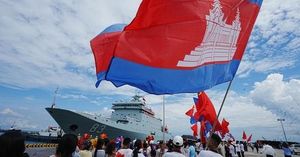Federal authorities have indicted Jonathan Caravello, a 37-year-old philosophy lecturer at California State University Channel Islands, on a charge of assaulting a federal officer with a deadly or dangerous weapon during a tumultuous raid on a California marijuana farm this past July. The incident, which unfolded at Glass House Farms—a sprawling 160-acre cannabis operation in Camarillo, Ventura County—has sparked heated debate about protest rights, law enforcement tactics, and the persistent shadow of labor exploitation in the state’s agricultural sector.
The events of July 10, 2025, began with a massive federal operation involving agents from Homeland Security Investigations (HSI) and the United States Border Patrol. According to the U.S. Attorney’s Office for the Central District of California, the agencies were executing a high-risk search warrant at the farm as part of a broader crackdown on illegal labor and trafficking in the region. As the sun rose over the fields, word of the raid spread swiftly, drawing a crowd of approximately 500 protesters to the farm’s entrance.
Protesters—some waving Mexican flags—assembled at the site, forming a human and vehicular barrier that blocked law enforcement from exiting the property. Tensions quickly escalated, with protesters hurling rocks at government vehicles, shattering windows and side-view mirrors, as described in court documents cited by Fox News and Breitbart Texas. The situation grew so volatile that federal agents resorted to deploying tear gas to disperse the crowd and ensure their own safety.
It was in this chaotic environment that Caravello, who resides in Ventura, allegedly made his move. Prosecutors allege that as Border Patrol agents rolled tear gas canisters toward the protesters’ feet, Caravello ran up to one of the canisters and attempted to kick it away. Missing his mark, he chased after the canister, picked it up, and threw it overhand back at the agents. The U.S. Attorney’s Office reported that Caravello was subsequently arrested, though not without resistance—he "continuously kicked his legs and refused to give agents his arms during the arrest," according to official statements.
Caravello is currently free on a $15,000 bond and is expected to be arraigned in the coming weeks at the United States District Court in Los Angeles. If convicted, he could face up to 20 years in federal prison—a stark reminder of the gravity with which the federal government views assaults on law enforcement officers, especially those involving potentially deadly weapons like tear gas canisters.
The university where Caravello teaches responded to the indictment with a measured statement, emphasizing the need for due process and declining to comment on the specifics of the case. "We are aware of the recent indictment involving Jonathan Caravello," California State University Channel Islands said. "As this matter is currently before the courts, we will not be commenting on the details of the case. We respect the legal process and believe it is important to allow it to proceed without speculation. Our focus remains on our ongoing work and commitments to our students." The university confirmed that Caravello "is still employed and currently teaching at our campus."
Shortly after the incident, university officials had also noted, "At this time, it is our understanding that Professor Caravello was peacefully participating in a protest—an act protected under the First Amendment and a right guaranteed to all Americans. If confirmed, we stand with elected officials and community leaders calling for his immediate release." This statement, reported by Breitbart News, highlights the complex interplay between the right to protest and the boundaries of lawful conduct during civil unrest.
The July 10 raid was not an isolated event. According to the Department of Homeland Security, federal agents conducted simultaneous marijuana farm raids in both Camarillo and Carpinteria that day. The operations resulted in the arrest of 361 undocumented immigrants and the rescue of at least 14 migrant children from Mexico and Honduras, who were allegedly being used in forced labor and trafficking violations. Fox News reported that one man taken into custody at Glass House Farms had a history of violent crime, including attempted child exploitation. Several other individuals arrested during the raids had prior convictions for offenses such as kidnapping, attempted rape, burglary, and child sex offenses, according to federal authorities.
The gravity of these underlying crimes provided the rationale for the aggressive law enforcement response. Yet, the protest that erupted in Camarillo underscored the deep divisions over immigration enforcement and the use of federal power in California—a state with a long history of activism and sanctuary policies. The presence of hundreds of protesters, some risking arrest to block law enforcement, speaks to the passionate opposition many Californians feel toward federal immigration raids, especially those involving vulnerable populations like children and migrant workers.
In the aftermath of the raid, federal officials offered a reward of up to $50,000 for information leading to the arrest of another suspect involved in the assaults on agents. The scale of the operation and the violence that erupted have made the incident a flashpoint in ongoing debates about border security, labor rights, and the limits of protest.
Caravello’s case has drawn national attention not just because of his academic standing, but also because it touches on broader questions about the responsibilities and risks of civil disobedience. The line between peaceful protest and criminal conduct can be razor-thin in moments of chaos. Supporters of Caravello argue that his actions were an expression of constitutionally protected dissent, while prosecutors maintain that throwing a tear gas canister at law enforcement crosses a clear legal boundary.
As the legal process unfolds, the university community and the wider public are left to grapple with difficult questions. What is the appropriate response when protest turns violent? How should institutions balance support for free speech with adherence to the law? And what measures can be taken to prevent the exploitation of vulnerable workers in California’s lucrative cannabis industry?
For now, Caravello remains in the classroom, his future uncertain as the courts prepare to weigh his actions against the backdrop of one of the most contentious raids in recent California history. The outcome of his case may set a precedent for how similar incidents are handled in the future—and serve as a cautionary tale for protesters, educators, and law enforcement alike.




